Cherokee vs Yakama Community Comparison
COMPARE
Cherokee
Yakama
Social Comparison
Social Comparison
Cherokee
Yakama
2,697
SOCIAL INDEX
24.5/ 100
SOCIAL RATING
243rd/ 347
SOCIAL RANK
1,331
SOCIAL INDEX
10.9/ 100
SOCIAL RATING
315th/ 347
SOCIAL RANK
Yakama Integration in Cherokee Communities
The statistical analysis conducted on geographies consisting of 19,547,276 people shows a very strong positive correlation between the proportion of Yakama within Cherokee communities in the United States with a correlation coefficient (R) of 0.854. On average, for every 1% (one percent) increase in Cherokee within a typical geography, there is an increase of 1.835% in Yakama. To illustrate, in a geography comprising of 100,000 individuals, a rise of 1,000 Cherokee corresponds to an increase of 1,835.3 Yakama.
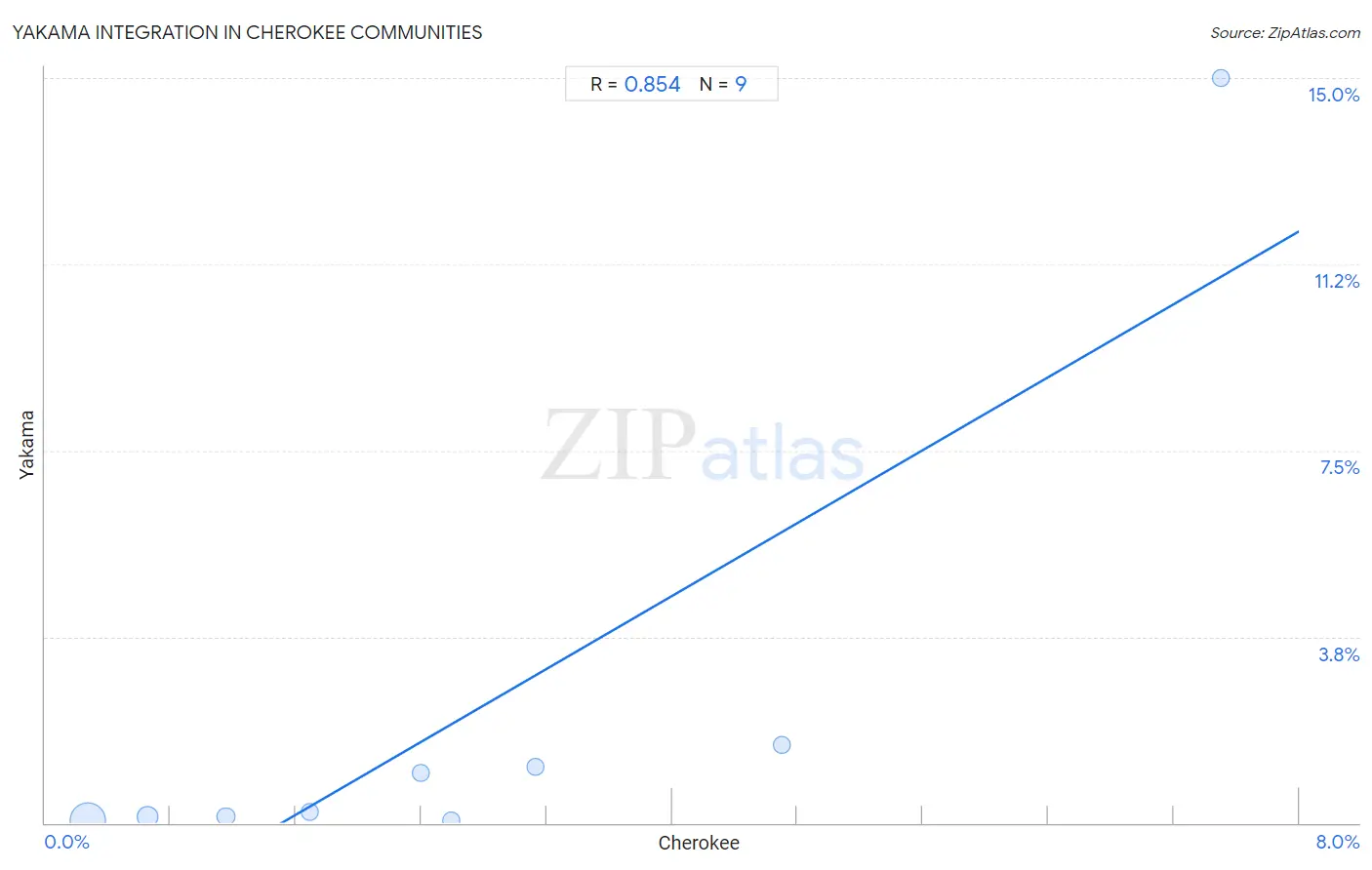
Cherokee vs Yakama Income
When considering income, the most significant differences between Cherokee and Yakama communities in the United States are seen in wage/income gap (27.4% compared to 23.7%, a difference of 15.4%), householder income under 25 years ($47,848 compared to $54,321, a difference of 13.5%), and per capita income ($37,203 compared to $33,009, a difference of 12.7%). Conversely, both communities are more comparable in terms of median household income ($72,682 compared to $72,225, a difference of 0.63%), householder income ages 45 - 64 years ($86,125 compared to $86,992, a difference of 1.0%), and householder income over 65 years ($54,133 compared to $56,234, a difference of 3.9%).

| Income Metric | Cherokee | Yakama |
| Per Capita Income | Tragic $37,203 | Tragic $33,009 |
| Median Family Income | Tragic $88,209 | Tragic $83,932 |
| Median Household Income | Tragic $72,682 | Tragic $72,225 |
| Median Earnings | Tragic $41,252 | Tragic $39,107 |
| Median Male Earnings | Tragic $48,669 | Tragic $45,002 |
| Median Female Earnings | Tragic $34,742 | Tragic $33,354 |
| Householder Age | Under 25 years | Tragic $47,848 | Exceptional $54,321 |
| Householder Age | 25 - 44 years | Tragic $80,843 | Tragic $76,226 |
| Householder Age | 45 - 64 years | Tragic $86,125 | Tragic $86,992 |
| Householder Age | Over 65 years | Tragic $54,133 | Tragic $56,234 |
| Wage/Income Gap | Tragic 27.4% | Exceptional 23.7% |
Cherokee vs Yakama Poverty
When considering poverty, the most significant differences between Cherokee and Yakama communities in the United States are seen in receiving food stamps (13.2% compared to 21.4%, a difference of 61.7%), married-couple family poverty (5.8% compared to 9.0%, a difference of 55.4%), and seniors poverty over the age of 75 (12.0% compared to 18.3%, a difference of 52.3%). Conversely, both communities are more comparable in terms of single male poverty (16.1% compared to 15.9%, a difference of 0.77%), female poverty among 25-34 year olds (17.2% compared to 17.6%, a difference of 2.6%), and single mother poverty (34.5% compared to 36.4%, a difference of 5.4%).
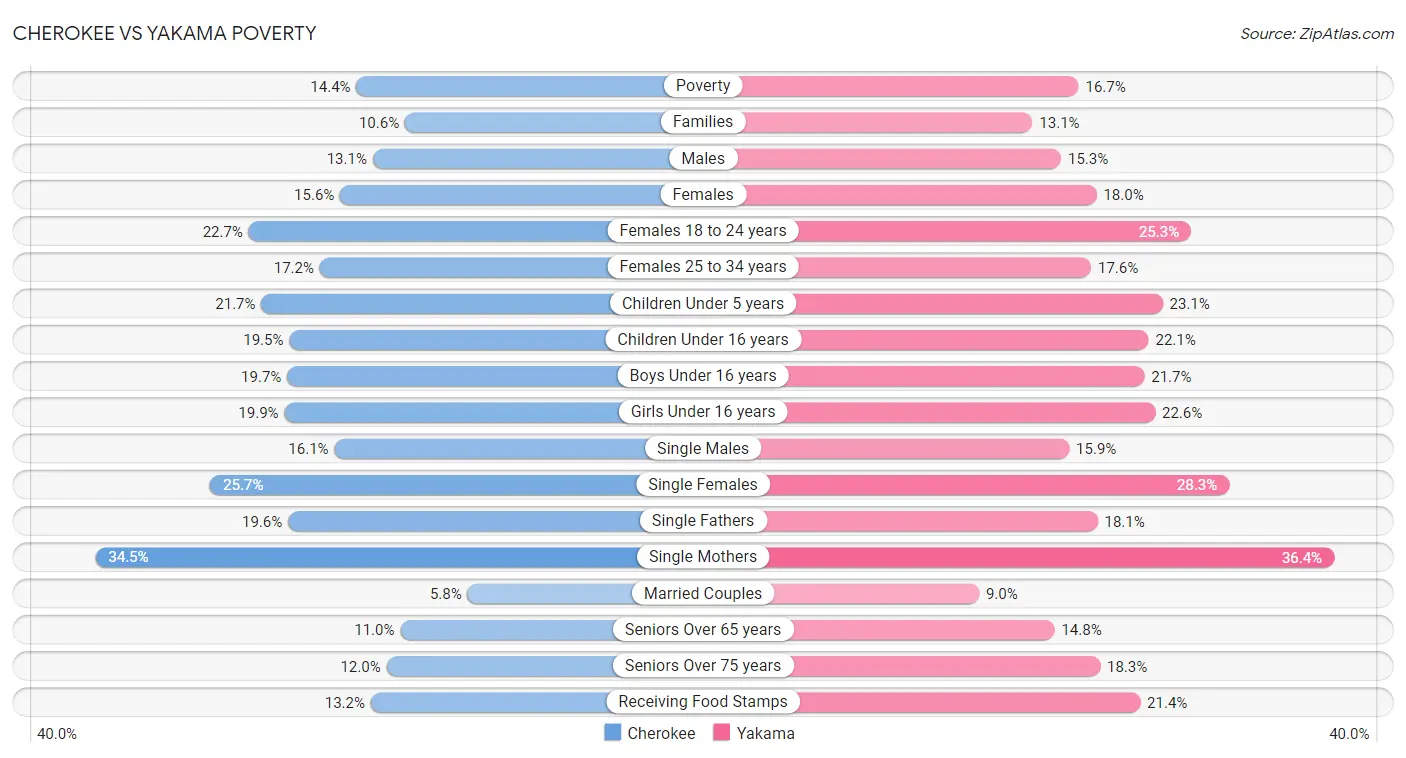
| Poverty Metric | Cherokee | Yakama |
| Poverty | Tragic 14.4% | Tragic 16.7% |
| Families | Tragic 10.6% | Tragic 13.1% |
| Males | Tragic 13.1% | Tragic 15.3% |
| Females | Tragic 15.6% | Tragic 18.0% |
| Females 18 to 24 years | Tragic 22.7% | Tragic 25.3% |
| Females 25 to 34 years | Tragic 17.2% | Tragic 17.6% |
| Children Under 5 years | Tragic 21.7% | Tragic 23.1% |
| Children Under 16 years | Tragic 19.5% | Tragic 22.1% |
| Boys Under 16 years | Tragic 19.7% | Tragic 21.7% |
| Girls Under 16 years | Tragic 19.9% | Tragic 22.6% |
| Single Males | Tragic 16.1% | Tragic 15.9% |
| Single Females | Tragic 25.7% | Tragic 28.3% |
| Single Fathers | Tragic 19.6% | Tragic 18.1% |
| Single Mothers | Tragic 34.5% | Tragic 36.4% |
| Married Couples | Tragic 5.8% | Tragic 9.0% |
| Seniors Over 65 years | Average 11.0% | Tragic 14.8% |
| Seniors Over 75 years | Good 12.0% | Tragic 18.3% |
| Receiving Food Stamps | Tragic 13.2% | Tragic 21.4% |
Cherokee vs Yakama Unemployment
When considering unemployment, the most significant differences between Cherokee and Yakama communities in the United States are seen in unemployment among seniors over 75 years (9.8% compared to 18.4%, a difference of 87.1%), unemployment among ages 55 to 59 years (5.0% compared to 8.9%, a difference of 78.8%), and unemployment among ages 30 to 34 years (6.4% compared to 9.8%, a difference of 53.2%). Conversely, both communities are more comparable in terms of unemployment among women with children ages 6 to 17 years (10.0% compared to 9.9%, a difference of 1.4%), unemployment among ages 35 to 44 years (5.2% compared to 5.6%, a difference of 7.8%), and unemployment among ages 25 to 29 years (7.6% compared to 8.8%, a difference of 15.7%).
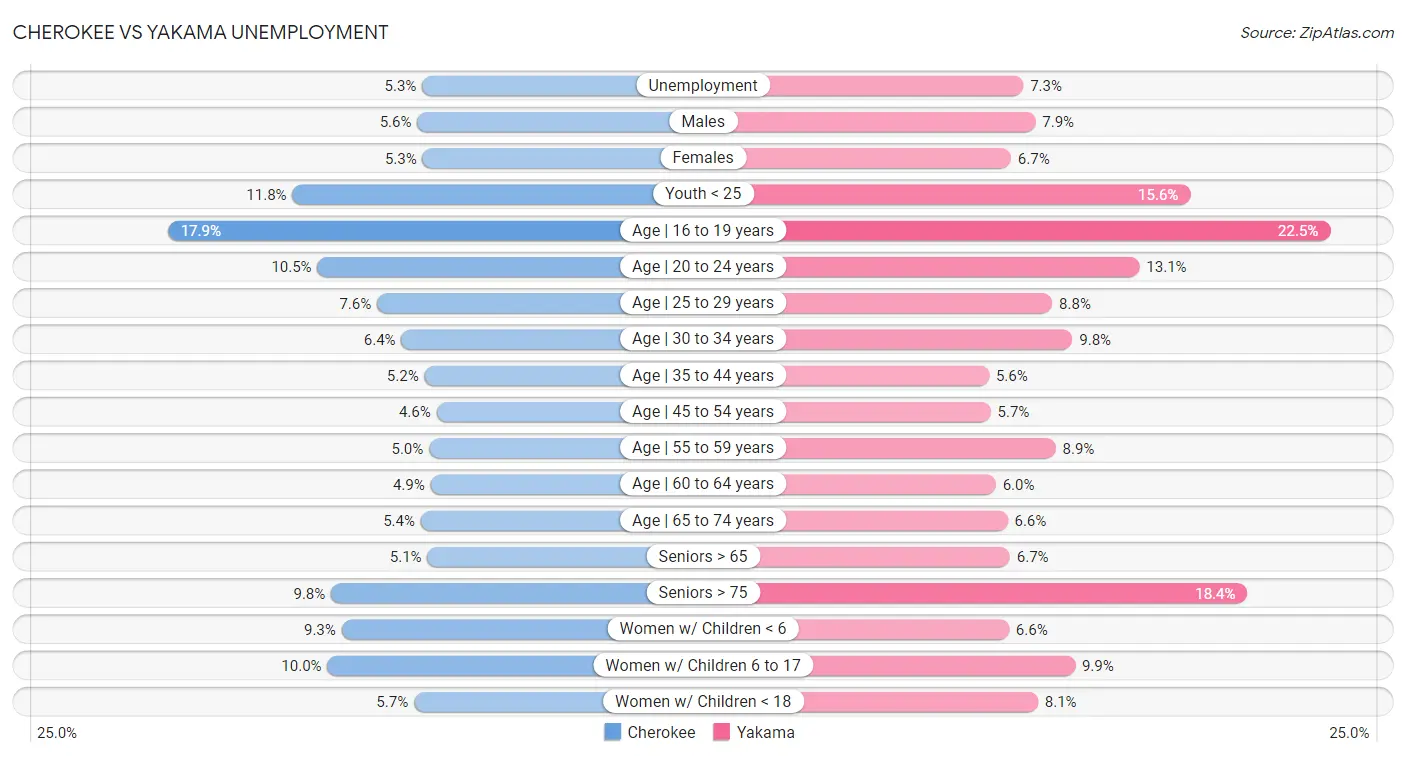
| Unemployment Metric | Cherokee | Yakama |
| Unemployment | Fair 5.3% | Tragic 7.3% |
| Males | Tragic 5.6% | Tragic 7.9% |
| Females | Fair 5.3% | Tragic 6.7% |
| Youth < 25 | Fair 11.8% | Tragic 15.6% |
| Age | 16 to 19 years | Poor 17.9% | Tragic 22.5% |
| Age | 20 to 24 years | Tragic 10.5% | Tragic 13.1% |
| Age | 25 to 29 years | Tragic 7.6% | Tragic 8.8% |
| Age | 30 to 34 years | Tragic 6.4% | Tragic 9.8% |
| Age | 35 to 44 years | Tragic 5.2% | Tragic 5.6% |
| Age | 45 to 54 years | Poor 4.6% | Tragic 5.7% |
| Age | 55 to 59 years | Tragic 5.0% | Tragic 8.9% |
| Age | 60 to 64 years | Poor 4.9% | Tragic 6.0% |
| Age | 65 to 74 years | Fair 5.4% | Tragic 6.6% |
| Seniors > 65 | Excellent 5.1% | Tragic 6.7% |
| Seniors > 75 | Tragic 9.8% | Tragic 18.4% |
| Women w/ Children < 6 | Tragic 9.3% | Exceptional 6.6% |
| Women w/ Children 6 to 17 | Tragic 10.0% | Tragic 9.9% |
| Women w/ Children < 18 | Tragic 5.7% | Tragic 8.1% |
Cherokee vs Yakama Labor Participation
When considering labor participation, the most significant differences between Cherokee and Yakama communities in the United States are seen in in labor force | age 16-19 (40.2% compared to 36.9%, a difference of 9.1%), in labor force | age 30-34 (81.6% compared to 79.1%, a difference of 3.1%), and in labor force | age 35-44 (81.4% compared to 79.0%, a difference of 3.1%). Conversely, both communities are more comparable in terms of in labor force | age > 16 (61.9% compared to 62.1%, a difference of 0.31%), in labor force | age 20-64 (76.2% compared to 75.8%, a difference of 0.59%), and in labor force | age 20-24 (75.9% compared to 75.1%, a difference of 1.1%).

| Labor Participation Metric | Cherokee | Yakama |
| In Labor Force | Age > 16 | Tragic 61.9% | Tragic 62.1% |
| In Labor Force | Age 20-64 | Tragic 76.2% | Tragic 75.8% |
| In Labor Force | Age 16-19 | Exceptional 40.2% | Good 36.9% |
| In Labor Force | Age 20-24 | Exceptional 75.9% | Average 75.1% |
| In Labor Force | Age 25-29 | Tragic 82.1% | Tragic 80.6% |
| In Labor Force | Age 30-34 | Tragic 81.6% | Tragic 79.1% |
| In Labor Force | Age 35-44 | Tragic 81.4% | Tragic 79.0% |
| In Labor Force | Age 45-54 | Tragic 79.0% | Tragic 80.6% |
Cherokee vs Yakama Family Structure
When considering family structure, the most significant differences between Cherokee and Yakama communities in the United States are seen in single father households (2.6% compared to 4.2%, a difference of 59.6%), single mother households (6.8% compared to 8.4%, a difference of 23.4%), and family households with children (27.5% compared to 30.8%, a difference of 12.0%). Conversely, both communities are more comparable in terms of married-couple households (46.7% compared to 45.2%, a difference of 3.3%), currently married (46.9% compared to 44.0%, a difference of 6.7%), and family households (65.0% compared to 69.3%, a difference of 6.7%).

| Family Structure Metric | Cherokee | Yakama |
| Family Households | Exceptional 65.0% | Exceptional 69.3% |
| Family Households with Children | Average 27.5% | Exceptional 30.8% |
| Married-couple Households | Good 46.7% | Tragic 45.2% |
| Average Family Size | Tragic 3.18 | Exceptional 3.45 |
| Single Father Households | Tragic 2.6% | Tragic 4.2% |
| Single Mother Households | Tragic 6.8% | Tragic 8.4% |
| Currently Married | Good 46.9% | Tragic 44.0% |
| Divorced or Separated | Tragic 13.7% | Tragic 12.3% |
| Births to Unmarried Women | Tragic 36.7% | Tragic 40.3% |
Cherokee vs Yakama Vehicle Availability
When considering vehicle availability, the most significant differences between Cherokee and Yakama communities in the United States are seen in 4 or more vehicles in household (7.7% compared to 12.9%, a difference of 67.1%), 3 or more vehicles in household (23.0% compared to 31.0%, a difference of 34.8%), and no vehicles in household (7.7% compared to 6.6%, a difference of 17.0%). Conversely, both communities are more comparable in terms of 1 or more vehicles in household (92.4% compared to 93.6%, a difference of 1.3%), 2 or more vehicles in household (59.9% compared to 64.9%, a difference of 8.4%), and no vehicles in household (7.7% compared to 6.6%, a difference of 17.0%).

| Vehicle Availability Metric | Cherokee | Yakama |
| No Vehicles Available | Exceptional 7.7% | Exceptional 6.6% |
| 1+ Vehicles Available | Exceptional 92.4% | Exceptional 93.6% |
| 2+ Vehicles Available | Exceptional 59.9% | Exceptional 64.9% |
| 3+ Vehicles Available | Exceptional 23.0% | Exceptional 31.0% |
| 4+ Vehicles Available | Exceptional 7.7% | Exceptional 12.9% |
Cherokee vs Yakama Education Level
When considering education level, the most significant differences between Cherokee and Yakama communities in the United States are seen in no schooling completed (1.7% compared to 3.6%, a difference of 104.3%), bachelor's degree (30.2% compared to 24.5%, a difference of 23.4%), and associate's degree (38.9% compared to 32.3%, a difference of 20.3%). Conversely, both communities are more comparable in terms of nursery school (98.3% compared to 96.6%, a difference of 1.8%), kindergarten (98.3% compared to 96.6%, a difference of 1.8%), and 1st grade (98.3% compared to 96.5%, a difference of 1.9%).
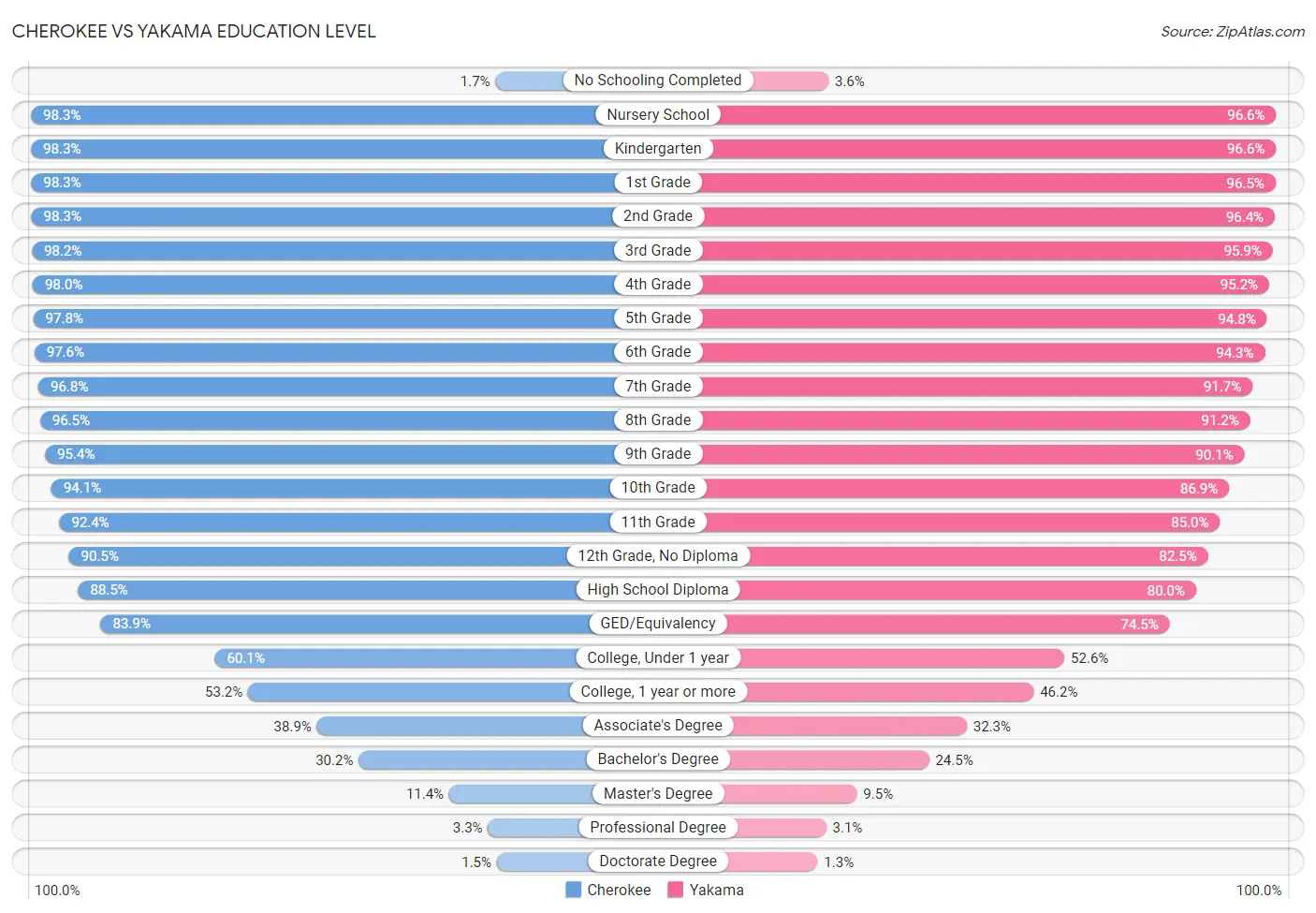
| Education Level Metric | Cherokee | Yakama |
| No Schooling Completed | Exceptional 1.7% | Tragic 3.6% |
| Nursery School | Exceptional 98.3% | Tragic 96.6% |
| Kindergarten | Exceptional 98.3% | Tragic 96.6% |
| 1st Grade | Exceptional 98.3% | Tragic 96.5% |
| 2nd Grade | Exceptional 98.3% | Tragic 96.4% |
| 3rd Grade | Exceptional 98.2% | Tragic 95.9% |
| 4th Grade | Exceptional 98.0% | Tragic 95.2% |
| 5th Grade | Exceptional 97.8% | Tragic 94.8% |
| 6th Grade | Exceptional 97.6% | Tragic 94.3% |
| 7th Grade | Exceptional 96.8% | Tragic 91.7% |
| 8th Grade | Exceptional 96.5% | Tragic 91.2% |
| 9th Grade | Exceptional 95.4% | Tragic 90.1% |
| 10th Grade | Excellent 94.1% | Tragic 86.9% |
| 11th Grade | Average 92.4% | Tragic 85.0% |
| 12th Grade, No Diploma | Tragic 90.5% | Tragic 82.5% |
| High School Diploma | Poor 88.5% | Tragic 80.0% |
| GED/Equivalency | Tragic 83.9% | Tragic 74.5% |
| College, Under 1 year | Tragic 60.1% | Tragic 52.6% |
| College, 1 year or more | Tragic 53.2% | Tragic 46.2% |
| Associate's Degree | Tragic 38.9% | Tragic 32.3% |
| Bachelor's Degree | Tragic 30.2% | Tragic 24.5% |
| Master's Degree | Tragic 11.4% | Tragic 9.5% |
| Professional Degree | Tragic 3.3% | Tragic 3.1% |
| Doctorate Degree | Tragic 1.5% | Tragic 1.3% |
Cherokee vs Yakama Disability
When considering disability, the most significant differences between Cherokee and Yakama communities in the United States are seen in disability age under 5 (1.8% compared to 1.00%, a difference of 77.3%), vision disability (2.9% compared to 2.5%, a difference of 18.1%), and ambulatory disability (7.9% compared to 6.8%, a difference of 15.6%). Conversely, both communities are more comparable in terms of cognitive disability (18.0% compared to 18.1%, a difference of 0.70%), disability age over 75 (50.2% compared to 51.3%, a difference of 2.1%), and disability age 18 to 34 (8.7% compared to 9.0%, a difference of 3.1%).
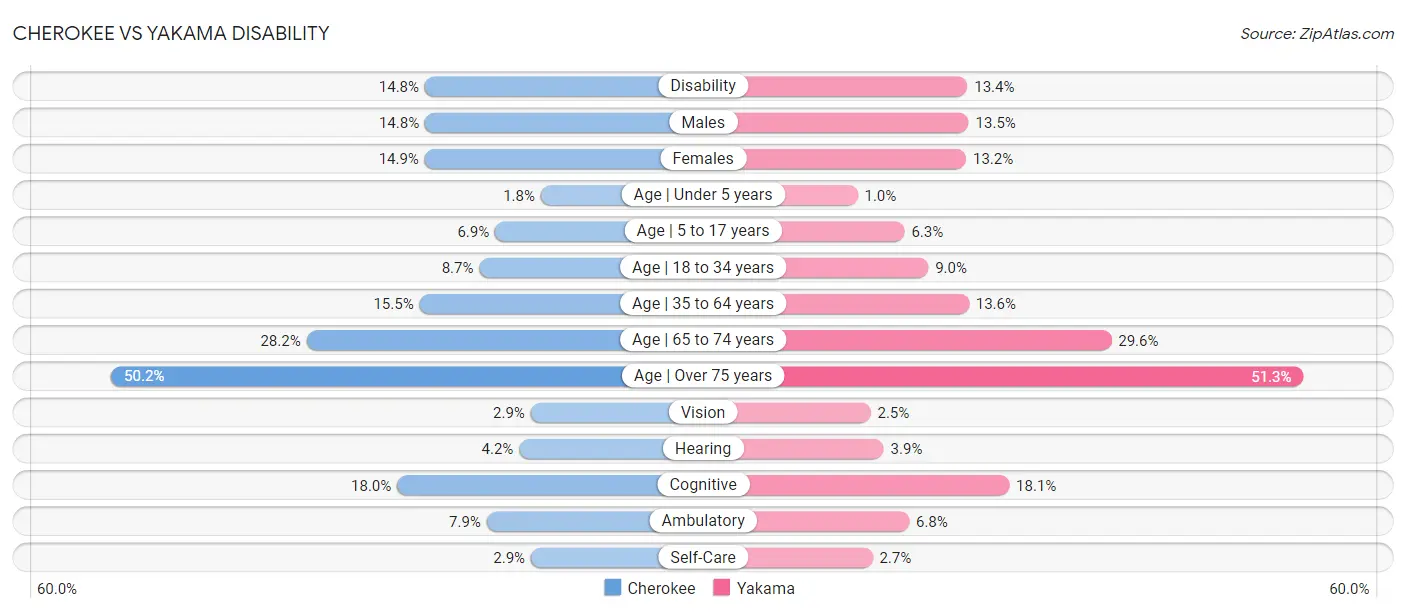
| Disability Metric | Cherokee | Yakama |
| Disability | Tragic 14.8% | Tragic 13.4% |
| Males | Tragic 14.8% | Tragic 13.5% |
| Females | Tragic 14.9% | Tragic 13.2% |
| Age | Under 5 years | Tragic 1.8% | Exceptional 1.00% |
| Age | 5 to 17 years | Tragic 6.9% | Tragic 6.3% |
| Age | 18 to 34 years | Tragic 8.7% | Tragic 9.0% |
| Age | 35 to 64 years | Tragic 15.5% | Tragic 13.6% |
| Age | 65 to 74 years | Tragic 28.2% | Tragic 29.6% |
| Age | Over 75 years | Tragic 50.2% | Tragic 51.3% |
| Vision | Tragic 2.9% | Tragic 2.5% |
| Hearing | Tragic 4.2% | Tragic 3.9% |
| Cognitive | Tragic 18.0% | Tragic 18.1% |
| Ambulatory | Tragic 7.9% | Tragic 6.8% |
| Self-Care | Tragic 2.9% | Tragic 2.7% |